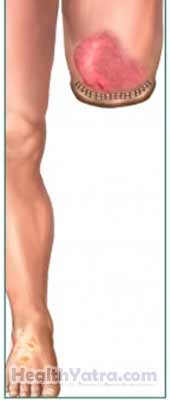Amputation General Surgery
An amputation is a surgery to remove a body part. It is removed because of disease or damage.

পদ্ধতির কারণ
An amputation is typically done for one of the following reasons:
- Peripheral arterial disease (PAD) causing:
- গ্যাংগ্রিন
- Untreatable pain
- Severe soft tissue infection
- Severe trauma that can not be repaired
- Complications of diabetes
- Untreatable bone infection ( osteomyelitis)
- Malignant tumor
- Congenital deformity (present at birth)
- Severe frostbite
- Complications of connective tissue diseases, such as:
- Lupus
- স্ক্লেরোডার্মা
সম্ভাব্য জটিলতা
If you are planning to have an amputation, your ডাক্তার একটি তালিকা পর্যালোচনা করবে সম্ভাব্য জটিলতা, যার মধ্যে অন্তর্ভুক্ত থাকতে পারে:
- Poor healing at amputation site, resulting in the need for a higher level of amputation
- Skin breakdown
- সংক্রমণ
- রক্তপাত
- Swelling at surgical site
- Phantom limb pain —feeling pain in amputated limb area
- Phantom sensation—feeling that amputated limb is still there
- রক্ত জমাট
- Complications of anesthesia
জটিলতার ঝুঁকি বাড়াতে পারে এমন কিছু কারণের মধ্যে রয়েছে:
- Peripheral vascular disease
- ডায়াবেটিস
- সংক্রমণ
- Prolonged immobility
- হৃদরোগ
- ধূমপান বা ফুসফুসের রোগ
- Blood clotting disorders
- Certain medicines (eg, steroids)
কি আশা করা যায়
পদ্ধতির আগে
Your amputation may be planned. In this case, your doctor will review with you how it is done and what to expect. An emergency amputation may need to be done. This can happen because of trauma or life-threatening infection. In this case, you may not have this preparation.
Depending on the injury and location, your doctor may do some of the following before your surgery:
- X-rays —a test that uses radiation to take a picture of structures inside the body, especially bones
- সিটি স্ক্যান—এক ধরনের এক্স-রে যা শরীরের ভিতরের কাঠামোর ছবি তুলতে কম্পিউটার ব্যবহার করে
- এমআরআই স্ক্যান - একটি পরীক্ষা যা শরীরের ভিতরের কাঠামোর ছবি তৈরি করতে চৌম্বকীয় তরঙ্গ ব্যবহার করে
- Bone scan to check for infection
- Tissue cultures
- রক্ত পরীক্ষা
- Heart evaluation
- Preoperative antibiotics
- Tests to evaluate blood flow in the part of the body that is being amputated
Leading up to your surgery:
- Arrange for a ride home from the hospital.
- Arrange for help at home after your surgery.
- Follow instructions for eating before surgery—usually nothing after midnight.
- You may be asked to use an antibacterial soap the morning of your surgery.
এনেস্থেশিয়া
This will depend on the body part operated on. You may receive:
- জেনারেল অ্যানেস্থেসিয়া - আপনি ঘুমিয়ে থাকবেন।
- Local anesthesia—A specific area will be numbed.
- Spinal anesthesia —Your lower body will be numb.
পদ্ধতির বর্ণনা
An incision will be made into the skin of the affected limb or limb part. If needed, the muscles will also be cut. Blood vessels will be tied off or sealed to prevent bleeding. The bone will then be cut through. The diseased or damaged body part will be removed.
Muscle will be pulled over the bone. It will be sutured in place there. The remaining skin will be pulled over the muscle. The skin will be sewn to form a stump. A sterile dressing will be placed over the incision.
If severe infection is involved, the incision may be left open to heal.
কতক্ষণ এটা লাগবে?
This procedure can take 20 minutes to several hours. The length will depend on the type of amputation being done.
এটা কতটা আঘাত করবে?
During the surgery, anesthesia will block any pain. After surgery, you will feel pain as you begin to heal. Your doctor will give a medicine to help manage pain. You may feel phantom pain, which is a feeling of pain in the amputated portion of the limb that is no longer present. If you do, tell your doctor so it can be treated.
গড় হাসপাতালে থাকার
Your hospital stay will depend on the type of amputation you had. Typically:
- Foot or toe amputation: 2-7 days
- Leg amputation: 2 days to 2 weeks
- Upper extremity: 7-12 days
- Finger amputation: 0-1 day
Your doctor may choose to keep you longer if complications arise.
পোস্ট-প্রক্রিয়া যত্ন
হাসপাতালে
After surgery, you can expect some of the following:
- The area involved will be elevated. This will decrease swelling.
- Your limb will be dressed in bulky dressing, elastic bandage, or cast.
- You will be encouraged to get up and walk as soon as possible.
- Physical therapy will begin within a day or two of surgery. It will focus on improving strength and mobility.
- You may wear a cast or special shoe for toe/foot amputations.
- You may be given certain medicines. This may include antibiotics or blood thinners.
- You will be fitted with a prosthesis as soon as your wound has healed.
ঘরে
Stitches will be removed within a few weeks of surgery. When you return home, do the following to help ensure a smooth recovery:
- If you smoke, quit. Smoking can interfere with healing.
- Follow the instructions for keeping your incision clean .
- Follow instructions on how to care for your prosthesis.
- Counseling may be recommended for the emotional trauma of an amputation.
- Attend follow up appointments with your doctor. They will make sure you are healing well.
- বাড়িতে কোন ওষুধ খেতে হবে সে সম্পর্কে আপনার ডাক্তারের সাথে যোগাযোগ করুন।
এছাড়াও, কখন গোসল করা, স্নান করা বা জলে ভিজানো নিরাপদ সে সম্পর্কে আপনার ডাক্তারকে জিজ্ঞাসা করুন।
আপনার ডাক্তারকে কল করুন
আপনি হাসপাতাল ছেড়ে যাওয়ার পরে, নিম্নলিখিতগুলির মধ্যে যেকোন একটি ঘটলে আপনার ডাক্তারকে কল করুন:
- জ্বর এবং ঠাণ্ডা সহ সংক্রমণের লক্ষণ
- Redness, swelling, increasing pain, excessive bleeding, or discharge from the incision sites
- Increasing or excessive pain
- কাশি, শ্বাসকষ্ট বা বুকে ব্যথা
- Severe nausea and vomiting
জরুরী পরিস্থিতিতে, অবিলম্বে চিকিৎসা সহায়তার জন্য কল করুন।
